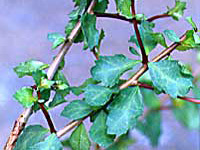Guggul (Commiphora weightii)

Introduction:
This plant is a source of Indian Bedellium, an oleo-gum-resin obtained by incision of the bark. The resin is largely used as incense and as a fixative in perfumery and in medicine.
Soil and climate :
It grows well in sandy to silt loam soils, which are poor in organic matter and rich in other matters and also considered as drought and salinity resistant plant. The plant has a wide adaptability and if found growing in arid regions under varying conditions. It grows in altitudes up to 600 – 1100 metres from sea level. The temperature ranges from 22-39°C.
Land preparation :
The land is prepared well in advance. In April month the land is ploughed having 6 x 6 feet spacing and digging pits having 2x2x2 feet volume. These pits are filled with 5 Kg of manure or compost and also 500 gms of neem barks are spread over it to avoid termites.
Propagation :
Guggal can be propagated either by seeds or vegetatively.
By seeds :
July- September is the time when seeds are more viable. Seeds are the natural mode of propagation; sloppy well-drained highly degraded lands are preferred for cultivation. They are sowed after monsoon when the humidity is relatively high. Matured seeds are sown and seedlings are raised through nursery bed and then transplanted after 6 months. The rate of seed germination is very poor i.e. 5% only, but seedlings produced by seed germination are healthier and can withstand high velocity wind.
By stem cuttings :
Before planting the stems need treatment. For vegetative propagation, stem cuttings are raised on nursery bed during June or October-November. The 25 to 30 cm long cuttings are placed at a depth of 15 cm for raising. The rooting starts after 21 days.
Transplanting & Spacing :
The plants are kept in nursery for 6-10 months and during next monsoon, the rooted cuttings are transplanted in the field at a space of 6x 6 feet.
Irrigation :
After establishment in the fields, it requires irrigation; but, when the plant attains maturity i.e. at the age of 6-7 years, it requires irrigation during summer and winter, at least twice in the season.
Weeding :
Weeding is necessary for the crop. This is beneficial in the months of September and December.
Harvesting :
Collection and tapping of gum resin:- After attaining complete maturity of plant, it is tapped from main stem. Tapping is carried out during December- February. The resin ducts occur in the bark portion near cambial layer. Plant attaining 7.5 cm diameter is suitable for tapping. Usually 1.5 cm deep circular incisions are made. Guggul oozes out as yellowish white aromatic latex like matter and slowly solidifies. It is collected manually or with spear. The collection is done at an interval of 10-15 days. The collected gum is graded according to its purity.
Yield :
Starting from the sixth year, yield of Olegum resin increases from 200 to 400 gm per plant. The total yield after 5 year is 1000-2000 gm per plant corresponding to 3200kg/hec for healthy plants.
Economics :
Yield per hectare after 5 years – 3200 kg/hec
Sale Price – Rs. 208000/- @ Rs. 65-85 per Kg approx.
Expenditure – Rs. 12000/- per hectare
Net profit/hectare/year – Rs. 54000/-
Source :
- Cultivation of medicinal and aromatic crops by A.A.Farooqi and B.S.Sreeramu.
- Cultivation of medicinal plants by Dr. C.K.Kokate, Dr. A.S.Gokhle and Prof. S.B.Gokhle
|

